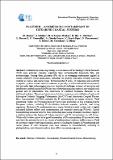Por favor, use este identificador para citar o enlazar a este item:
http://hdl.handle.net/10261/203156COMPARTIR / EXPORTAR:
 SHARE
BASE SHARE
BASE
|
|
| Visualizar otros formatos: MARC | Dublin Core | RDF | ORE | MODS | METS | DIDL | DATACITE | |

| Título: | Platinum - an emerging contaminant in estuarine/coastal systems |
Autor: | Abdou, Melina; Schäfer, Jörg; Tercier-Waeber, M. L.; Hu, R.; Gil-Díaz, T.; Dutruch, L.; Catrouillet, Charlotte; Cobelo-García, A. CSIC ORCID; Brach-Papa, C.; Charmasson, Sabine; Massa, F.; Castellano, M.; Blanc, Gérard | Palabras clave: | Platinum Distribution Contamination Estuarine/Coastal Systems Biomonitoring |
Fecha de publicación: | 2019 | Editor: | Consejo Superior de Investigaciones Científicas (España) | Citación: | Abstracts Volume XV International Estuarine Biogeochemistry Symposium: 31-32 (2019) | Resumen: | Continuously increasing mining, use and release of Technology Critical Elements (TCE) pose growing concerns regarding their environmental dispersion, fate, and ecotoxicology. Among them, platinum (Pt) still is an emerging contaminant applied in various relatively recent applications, including car catalytic converters (vehicle emission control) as well as anti-cancer drugs. Environmental Pt levels, its behaviour and reactivity in aquatic systems remain widely unknown, especially in estuarine/coastal environments that are under high anthropogenic pressure. Analytical challenges in terms of sensitivity and interference control required for Pt ultra-trace detection in marine matrices may explain such general lack of information. The inexistence of Certified Reference Materials is an additional problem. The present work presents Inter-comparison and validation of optimised Adsorptive Cathodic Stripping Voltammetry (Ad-CSV) and Inductively Coupled Plasma- Mass Spectrometry (ICP-MS) methods for Pt measurements in marine bivalves. Field monitoring studies on Pt biogeochemistry have been performed in key estuarine/coastal European systems, including Pt distribution between seawater, particles, and living organisms. Historical Pt contamination in a major fluvial-estuarine system and a highly urbanized harbour reflects past contamination and currently increasing Pt levels. Spatial biomonitoring in marine bivalves from contrasting areas along urbanized coastlines suggests a relation between the degree of “urban exposure” and Pt concentrations in soft tissues. While wild bivalves prove to be good biomonitors of Pt contamination, Pt in coastal water may have the potential to serve as a tracer of modern urban (medical, traffic) sources. Field observations suggest that biogeochemical processes leading to changes in Pt partitioning and carrier phases at short temporal scale may enhance its bioavailability, including in phytoplankton, and ultimately induce toxic effects on marine organisms | Descripción: | 2 pages.-- XV International Estuarine Biogeochemistry Symposium, Vigo, June 04-05 2019 | URI: | http://hdl.handle.net/10261/203156 | ISBN: | 978-84-120734-0-9 |
| Aparece en las colecciones: | (IIM) Libros y partes de libros |
Ficheros en este ítem:
| Fichero | Descripción | Tamaño | Formato | |
|---|---|---|---|---|
| Platinum_emerging_2019.pdf | 560,81 kB | Adobe PDF |  Visualizar/Abrir |
CORE Recommender
Page view(s)
170
checked on 23-abr-2024
Download(s)
70
checked on 23-abr-2024
Google ScholarTM
Check
Altmetric
NOTA: Los ítems de Digital.CSIC están protegidos por copyright, con todos los derechos reservados, a menos que se indique lo contrario.
